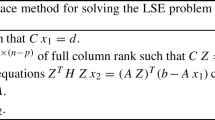Abstract
The G-algorithm was proposed by Bareiss [1] as a method for solving the weighted linear least squares problem. It is a square root free algorithm similar to the fast Givens method except that it triangularizes a rectangular matrix a column at a time instead of one element at a time.
In this paper an error analysis of the G-algorithm is presented which shows that it is as stable as any of the standard orthogonal decomposition methods for solving least squares problems. The algorithm is shown to be a competitive method for sparse least squares problems.
A pivoting strategy is given for heavily weighted problems similar to that in [14] for the Householder-Golub algorithm. The strategy is prohibitively expensive, but it is not necessary for most of the least squares problems that arise in practice.
Similar content being viewed by others
References
E. H. Bareiss,Numerical solution of the weighted linear least squares problem by G-transformations, Technical Report No. 82-03-NAM-03, Department of Electrical Engineering and Computer Science, Northwestern University, Evanston, Illinois, April 1982, (accepted in SIAM J. Alg. Discrete Methods).
J. L. Barlow,Stability analysis of the G-algorithm and a note on its application to sparse least squares problems, CS-84-08, Dept. of Computer Science, The Pennsylvania State University, University Park, PA, August 1984.
P. A. Businger and G. H. Golub,Linear least squares solutions by Householder transformation Num. Math. 7 (1965), pp. 269–28.
W. M. Gentleman,Least squares computations by Givens rotations without square roots, J. Inst. Math. Appl. 12 (1973), pp. 329–336.
W. M. Gentleman,Error analysis of QR decompositions by Givens transformations, Lin. Alg. Appl. 10 (1975), pp. 189–197.
J. A. George and E. Ng,On row and column orderings for sparse least squares problems, Siam. J. Numer. Anal. 20 (1983), pp. 326–44.
P. E. Gill, W. Murray and M. A. Saunders,Methods for computing and modifying the LDV factors of a matrix, Math. Comp. 29 (1975), pp. 1051–77.
S. Hammarling,A note on modifications to the Givens plane rotation, J. Inst. Math. Appl. 13 (1974), pp. 215–218.
L. C. Kaufman,Application of dense Householder transformations to a sparse matrix, ACM Trans. Math. Soft. 5 (1979), pp. 442–50.
C. L. Lawson and R. J. Hanson,Solving Least Squares Problems, Prentice Hall, Englewood Cliff, N.J., 1974.
C. C. Paige,Numerically stable computations for general univariate linear models, Commun. Statist.-Simula, Computa, B7 (5), (1978), pp. 437–53.
C. C. Paige,Computer solution and perturbation analysis of generalized linear squares problems, Math. Comp. 33 (1979), pp. 171–83.
C. C. Paige,Fast numerically stable computations for generalized linear least squares problems, Siam. J. Numer. Anal. 16 (1979), pp. 165–71.
M. J. D. Powell and J. K. Reid,On applying Householder transformations to linear least squares problems, Proc. IFIP Congress 4 (1968), pp. 122–6.
C. F. Van Loan,A generalized SVD analysis of some weighting methods for equality constrained least squares, in Matrix Pencils, vol. 973, B. Kågström and A. Ruhe (eds.), 1982, pp. 245–62.
J. H. Wilkinson,Error analysis of direct methods of matrix inversion, J. ACM 8 (1961), pp. 281–330.
J. H. Wilkinson,The Algebraic Eigenvalue Problem, Oxford University Press, London, 1965.
Author information
Authors and Affiliations
Additional information
The research was supported by the National Science Foundation under contract no. MCS-8201065 and by the Office of Naval Research under contract no. N0014-80-0517.
Rights and permissions
About this article
Cite this article
Barlow, J.L. Stability analysis of the G-algorithm and a note on its application to sparse least squares problems. BIT 25, 507–520 (1985). https://doi.org/10.1007/BF01935371
Received:
Revised:
Issue Date:
DOI: https://doi.org/10.1007/BF01935371




